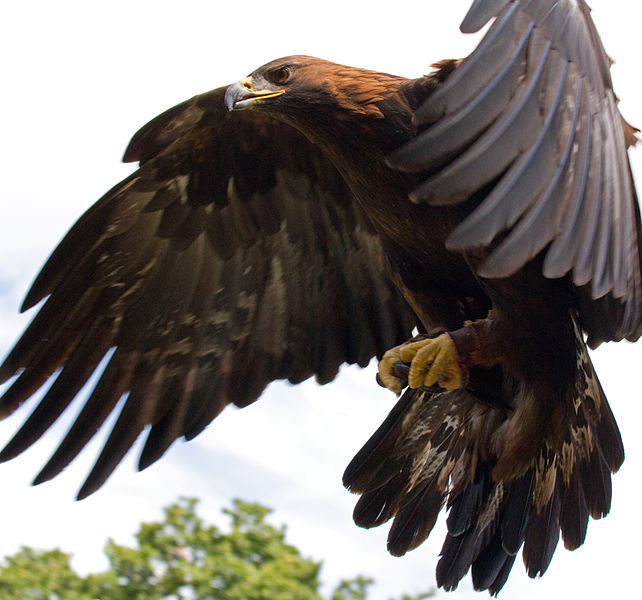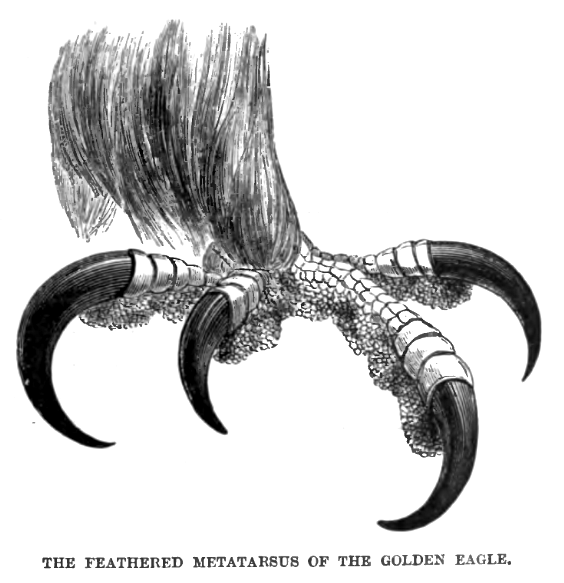Form and Function
Aquila chrysaetos, commonly known as the
Golden Eagle, is notorious for being North America’s largest bird of
prey, with a wingspan of five to seven feet (Ferguson-Lees,
2001). Since A. chrysaetos does little to no nest building,
they find shelter for nesting on cliff faces and open ledges
(Watson, 2010). To adapt to this rough environment Aquila chrysaetos
has developed great flying skills. These great birds use their
massive wings to propel them through the air at speeds up to 200 mph
when in full stoop after prey. Golden Eagles have been found to
travel up to 60 to 90 miles per day for migratory purposes using
their flight skills to their advantage (Watson, 2010). By launching
itself at prey, mainly small rodents, such as ground squirrels,
mice, and
weasels, Aquila chrysaetos shows its spot at the top of
the food chain is well deserved. Golden Eagles have even been known
to kill larger mammals such as goats by throwing them off of high
cliffs (Tesky, 1994).
chrysaetos
has developed great flying skills. These great birds use their
massive wings to propel them through the air at speeds up to 200 mph
when in full stoop after prey. Golden Eagles have been found to
travel up to 60 to 90 miles per day for migratory purposes using
their flight skills to their advantage (Watson, 2010). By launching
itself at prey, mainly small rodents, such as ground squirrels,
mice, and
weasels, Aquila chrysaetos shows its spot at the top of
the food chain is well deserved. Golden Eagles have even been known
to kill larger mammals such as goats by throwing them off of high
cliffs (Tesky, 1994).
In an experiment done on the predatory functional
morphology of raptors, it was found that a bird’s talons are not
used to kill their prey. Instead, if the animal is not paralyzed by
the initial blow of the attack the talons are then used to kill by
thoracic compression (Fowler, Freedman, and Scannella, 2009).
Aquila
 chrysaetos, along with other birds of prey such as the
Bald
Eagle, are known
for their keen eyesight and sense of hearing. The eagles “hawk-
eyes” are what truly make them the amazing hunters they are.
“Long-range stoops, which rely on the eagle’s keen eyesight and on
high-speed flight are used to catch dispersed prey in the open
country” (Watson, 2010). There have been recent discoveries that
show bird
chrysaetos, along with other birds of prey such as the
Bald
Eagle, are known
for their keen eyesight and sense of hearing. The eagles “hawk-
eyes” are what truly make them the amazing hunters they are.
“Long-range stoops, which rely on the eagle’s keen eyesight and on
high-speed flight are used to catch dispersed prey in the open
country” (Watson, 2010). There have been recent discoveries that
show birds may even have a sharper sense of smell than we originally
believed. It was once believed that birds were anosmic, otherwise
known as having no sense of smell, but it has been found that they
use their sense of smell for activities such as finding mates and
directing themselves home (Lipske, 2013). Another way in which the
Golden Eagle adapts to its environment is through its flight skills.
In a study conducted on the migratory patterns of Aquila
chrysaetos affected by meteorological conditions, it shows the
migrating raptors adjusted their flight styles to fit the wind lift,
this helped them in terms of the energy cost of migration (Lanzone
et al., 2012).
Read more about how the Golden Eagle's form and function affects their reproduction.
Return to Aquila chrysaetos homepage.